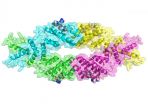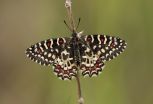(Press-News.org) Grand Rapids, Michigan (July 24, 2015)--Scientists at Van Andel Research Institute (VARI) have revealed an important molecular mechanism in plants that has significant similarities to certain signaling mechanisms in humans, which are closely linked to early embryonic development and to diseases such as cancer.
In plants as in animals and humans, intricate molecular networks regulate key biological functions, such as development and stress responses. The system can be likened to a massive switchboard--when the wrong switches are flipped, genes can be inappropriately turned on or off, leading to the onset of diseases.
Now, VARI scientists have unraveled how an important plant protein, known as TOPLESS, interacts with other molecules responsible for turning genes off. The findings in plants provide a general model across species for this type of gene silencing, which is linked to several vital biological functions in humans. The discovery was published today in Science Advances.
"This is really a fundamental discovery--our structure shows the corepressor TOPLESS interacting with key repressor motifs, which constitutes a major component of gene silencing in plants," said Van Andel Research Institute's Karsten Melcher, Ph.D., one of the study's corresponding authors. "Understanding this interaction in plants gives us unique insight into similar pathways in humans that involve these proteins, which are notoriously tough to investigate."
Using a method called X-ray crystallography, the team determined the three- dimensional structure of TOPLESS, both on its own and when linked with other molecules responsible for turning genes off, thereby regulating gene expression. Although these interacting molecules were chosen from different signaling pathways in plants, they all linked up with TOPLESS in the same manner
"This structure will allow us to take a more targeted approach to investigating TOPLESS's counterparts in humans and significantly expands our knowledge base," said VARI's H. Eric Xu, Ph.D., who also is a corresponding author. "We're extremely excited to continue this work to better understand these proteins and how they interact with other molecules in health and disease states."
The new paper is the third in a trio of publications that unveil key components of fundamental molecular processes. Although the new study provides further insight into human molecular pathways, the work also directly describes how components of the molecular switchboard in plants interact to regulate responses to a multitude of stressors, including temperature fluctuations. The new findings follow an earlier Nature paper, which was included in the top ten list of scientific breakthroughs of 2009 by Science magazine, and an earlier Science paper, both of which describe how plants respond to drought and temperature stress. Taken together, the papers not only have implications for developing hardier plants but also for determining molecular structures for components of entire pathways.
Authors include Jiyuan Ke, Honglei Ma, and Xin Gu of VARI and VARI-Shanghai Institute of Materia Medica; Jiayang Li of the Chinese Academy of Sciences; Joseph S. Brunzelle of Northwestern University; and Adam Thelen, now at Michigan State University.
INFORMATION:
Additional background information on TOPLESS and gene regulation:
Gene expression is regulated by both activators and repressors. Although gene repression is thought to be equally important as gene activation for this regulation, relatively little is known about the mechanisms of gene repressors and co-repressors.
TOPLESS functions as a co-repressor and interacts with repressors containing ethylene-responsive element binding factor-associated amphiphilic repression (EAR) motifs. EAR motifs are the most common form of transcriptional repression motifs found in plants and are thought to facilitate stable epigenetic regulation of gene expression via recruitment of chromatin modifiers.
TOPLESS plays important roles in plant development; its name stems from the fact that mutations in TOPLESS can give rise to seedlings in which the shoot is transformed into a second root, hence "topless" seedlings.
In humans, similar proteins also are altered in many types of tumors, and control embryonic development and the development of neurons.
ABOUT VAN ANDEL RESEARCH INSTITUTE:
Van Andel Institute (VAI) is an independent biomedical research and science education organization committed to improving the health and enhancing the lives of current and future generations. Established by Jay and Betty Van Andel in 1996 in Grand Rapids, Michigan, VAI has grown into a premier research and educational institution that supports the work of more than 270 scientists, educators and staff. Van Andel Research Institute (VARI), VAI's research division, is dedicated to determining the epigenetic, genetic, molecular and cellular origins of cancer, Parkinson's and other diseases and translating those findings into effective therapies. The Institute's scientists work in on-site laboratories and participate in collaborative partnerships that span the globe. Learn more about Van Andel Institute or donate by visiting http://www.vai.org. 100% To Research, Discovery & Hope®
ORLANDO, Fla. (July 21, 2015) - A new peer-reviewed study published in the Journal of Mammalogy by the Oxford University Press adds important insights to the debate over how long killer whales in human care live. The study found no difference in life expectancy between killer whales born at SeaWorld and a well-studied population of wild killer whales.
The study, "Comparisons of life-history parameters between free-ranging and captive killer whale (Orcinus orca) populations for application toward species management," compares current published data for survival and ...
You don't think you're hungry, then a friend mentions how hungry he is or you smell some freshly baked pizza and whoaaa, you suddenly feel really hungry. Or, you've had surgery and need a bit of morphine for pain. As soon as you hit that button you feel relief even though the medicine hasn't even hit your bloodstream.
These are two examples of the oft-studied placebo effect that demonstrate the amazing and still somewhat confounding powers of the human brain.
Now, CU-Boulder graduate student Scott Schafer, who works in Associate Professor Tor Wager's Cognitive and Affective ...
The health of Colorado's bighorn sheep population remains as precarious as the steep alpine terrain the animals inhabit, but a new study led by researchers at the University of Colorado Boulder has found that inbreeding--a common hypothesis for a recent decline--likely isn't to blame.
Bighorn herds tend to be small and isolated in their mountain ecosystems, putting the animals at high risk for a genetic "bottleneck," said Catherine Driscoll, a graduate student in the Department of Ecology and Evolutionary Biology at CU-Boulder and lead author of the study. Previous research ...
As well as the daily strain of their working lives, shift workers are probably also more likely than other people to develop cancer. While this has been well described for breast cancer, few studies had examined the correlation between shift work and prostate cancer. In a recent original article in Deutsches Ärzteblatt International (Dtsch Arztbl Int 112: 463-70), Gael P. Hammer et al. show that shift workers do not develop prostate cancer more frequently than their colleagues who work during the day.
Shift work is widespread: between approximately one in five and ...
CAMBRIDGE, Mass. -- John Leonard's group in the MIT Department of Mechanical Engineering specializes in SLAM, or simultaneous localization and mapping, the technique whereby mobile autonomous robots map their environments and determine their locations.
Last week, at the Robotics Science and Systems conference, members of Leonard's group presented a new paper demonstrating how SLAM can be used to improve object-recognition systems, which will be a vital component of future robots that have to manipulate the objects around them in arbitrary ways.
The system uses SLAM ...
This news release is available in Spanish.
Since 2006, the team of researchers has sequenced the mitochondrial DNA of all the known species of butterflies in the Iberian peninsula (228) and its main populations. The result is a report that compiles more than 3500 genetic sequences of all the species, which have been compared to the genetic sequences of other European populations. The paper has 277 pages of supplementary material, including pictures and 80 maps of the geographical distribution of the butterfly genetic lineages identified.
This is the first time ...
(Philadelphia, PA) - Patients who have lower extremity proximal deep vein thrombosis (LE-DVT), or a blood clot in their leg, are increasingly undergoing minimally invasive catheter-based blood clot removal - also referred to as catheter-directed thrombolysis (CDT) - rather than solely being treated with traditional blood-thinning medications (anticoagulation alone). This trend is due to recent literature showing reductions in lifestyle-limiting post-thrombotic complications of acute DVT in patients who undergo CDT compared to those that are treated with anticoagulation ...
This news release is available in German.
Pathogenic bacteria develop killer machines that work very specifically and highly efficiently. Scientists from the University of Freiburg have solved the molecular mechanism of a fish toxin that could be used in the future as a medication to treat cancer. The scientists have now published their research in the journal Nature Communications.
The Yersinia species of pathogens can cause the bubonic plague and serious gastrointestinal infections in humans. The pharmacologist Dr. Thomas Jank and his fellow researchers in the ...
La Jolla, Calif., July 23, 2015 - A new study by researchers at Sanford Burnham Prebys Medical Discovery Institute (SBP), the National Cancer Institute, and the Chulabhorn Research Institute has found that blocking the activity of a key immune receptor, the lymphotoxin-beta receptor (LTβR), reduces the progression of liver cancer. The results, published today in the online edition of Gut, could provide new treatment strategies for the disease, which is the third leading cause of cancer-related deaths worldwide.
"Our findings point to a new way to improve the treatment ...
After decades of overtreatment for low-risk prostate cancer and inadequate management of its more aggressive forms, patients are now more likely to receive medical care matched to level of risk, according to a study by researchers at UC San Francisco.
In the first study to document updated treatment trends, researchers found that from 2010 to 2013, 40 percent of men with low-risk prostate cancer opted for active surveillance, in which the disease is monitored closely with blood tests, imaging studies and biopsies. Treatment is deferred unless these tests show evidence ...



